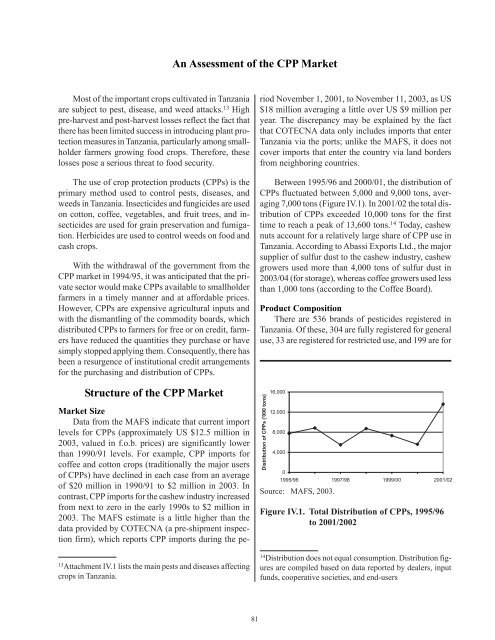An Action Plan for Developing Agricultural Input Markets in Tanzania
An Action Plan for Developing Agricultural Input Markets in Tanzania
An Action Plan for Developing Agricultural Input Markets in Tanzania
You also want an ePaper? Increase the reach of your titles
YUMPU automatically turns print PDFs into web optimized ePapers that Google loves.
Most of the important crops cultivated <strong>in</strong> <strong>Tanzania</strong><br />
are subject to pest, disease, and weed attacks. 13 High<br />
pre-harvest and post-harvest losses reflect the fact that<br />
there has been limited success <strong>in</strong> <strong>in</strong>troduc<strong>in</strong>g plant protection<br />
measures <strong>in</strong> <strong>Tanzania</strong>, particularly among smallholder<br />
farmers grow<strong>in</strong>g food crops. There<strong>for</strong>e, these<br />
losses pose a serious threat to food security.<br />
The use of crop protection products (CPPs) is the<br />
primary method used to control pests, diseases, and<br />
weeds <strong>in</strong> <strong>Tanzania</strong>. Insecticides and fungicides are used<br />
on cotton, coffee, vegetables, and fruit trees, and <strong>in</strong>secticides<br />
are used <strong>for</strong> gra<strong>in</strong> preservation and fumigation.<br />
Herbicides are used to control weeds on food and<br />
cash crops.<br />
With the withdrawal of the government from the<br />
CPP market <strong>in</strong> 1994/95, it was anticipated that the private<br />
sector would make CPPs available to smallholder<br />
farmers <strong>in</strong> a timely manner and at af<strong>for</strong>dable prices.<br />
However, CPPs are expensive agricultural <strong>in</strong>puts and<br />
with the dismantl<strong>in</strong>g of the commodity boards, which<br />
distributed CPPs to farmers <strong>for</strong> free or on credit, farmers<br />
have reduced the quantities they purchase or have<br />
simply stopped apply<strong>in</strong>g them. Consequently, there has<br />
been a resurgence of <strong>in</strong>stitutional credit arrangements<br />
<strong>for</strong> the purchas<strong>in</strong>g and distribution of CPPs.<br />
Structure of the CPP Market<br />
Market Size<br />
Data from the MAFS <strong>in</strong>dicate that current import<br />
levels <strong>for</strong> CPPs (approximately US $12.5 million <strong>in</strong><br />
2003, valued <strong>in</strong> f.o.b. prices) are significantly lower<br />
than 1990/91 levels. For example, CPP imports <strong>for</strong><br />
coffee and cotton crops (traditionally the major users<br />
of CPPs) have decl<strong>in</strong>ed <strong>in</strong> each case from an average<br />
of $20 million <strong>in</strong> 1990/91 to $2 million <strong>in</strong> 2003. In<br />
contrast, CPP imports <strong>for</strong> the cashew <strong>in</strong>dustry <strong>in</strong>creased<br />
from next to zero <strong>in</strong> the early 1990s to $2 million <strong>in</strong><br />
2003. The MAFS estimate is a little higher than the<br />
data provided by COTECNA (a pre-shipment <strong>in</strong>spection<br />
firm), which reports CPP imports dur<strong>in</strong>g the pe-<br />
13Attachment IV.1 lists the ma<strong>in</strong> pests and diseases affect<strong>in</strong>g<br />
crops <strong>in</strong> <strong>Tanzania</strong>.<br />
<strong>An</strong> Assessment of the CPP Market<br />
81<br />
riod November 1, 2001, to November 11, 2003, as US<br />
$18 million averag<strong>in</strong>g a little over US $9 million per<br />
year. The discrepancy may be expla<strong>in</strong>ed by the fact<br />
that COTECNA data only <strong>in</strong>cludes imports that enter<br />
<strong>Tanzania</strong> via the ports; unlike the MAFS, it does not<br />
cover imports that enter the country via land borders<br />
from neighbor<strong>in</strong>g countries.<br />
Between 1995/96 and 2000/01, the distribution of<br />
CPPs fluctuated between 5,000 and 9,000 tons, averag<strong>in</strong>g<br />
7,000 tons (Figure IV.1). In 2001/02 the total distribution<br />
of CPPs exceeded 10,000 tons <strong>for</strong> the first<br />
time to reach a peak of 13,600 tons. 14 Today, cashew<br />
nuts account <strong>for</strong> a relatively large share of CPP use <strong>in</strong><br />
<strong>Tanzania</strong>. Accord<strong>in</strong>g to Abassi Exports Ltd., the major<br />
supplier of sulfur dust to the cashew <strong>in</strong>dustry, cashew<br />
growers used more than 4,000 tons of sulfur dust <strong>in</strong><br />
2003/04 (<strong>for</strong> storage), whereas coffee growers used less<br />
than 1,000 tons (accord<strong>in</strong>g to the Coffee Board).<br />
Product Composition<br />
There are 536 brands of pesticides registered <strong>in</strong><br />
<strong>Tanzania</strong>. Of these, 304 are fully registered <strong>for</strong> general<br />
use, 33 are registered <strong>for</strong> restricted use, and 199 are <strong>for</strong><br />
Source: MAFS, 2003.<br />
Figure IV.1. Total Distribution of CPPs, 1995/96<br />
to 2001/2002<br />
14 Distribution does not equal consumption. Distribution figures<br />
are compiled based on data reported by dealers, <strong>in</strong>put<br />
funds, cooperative societies, and end-users

















